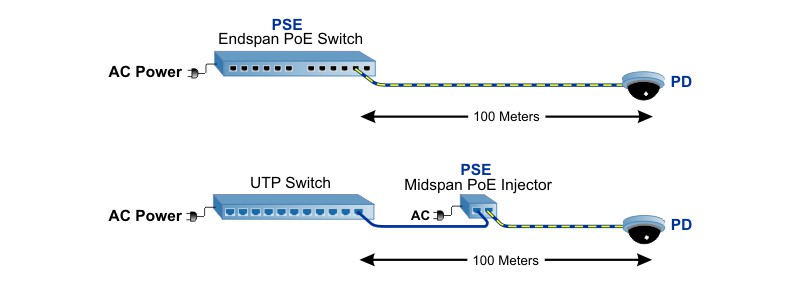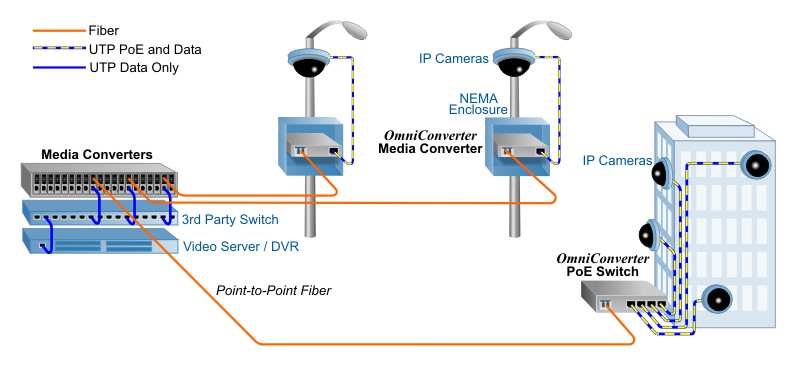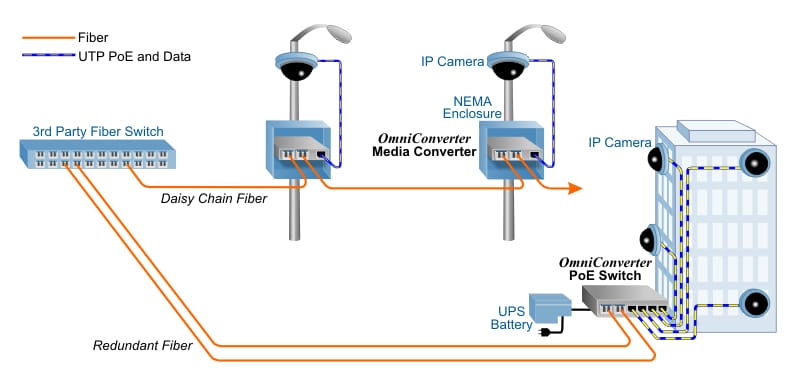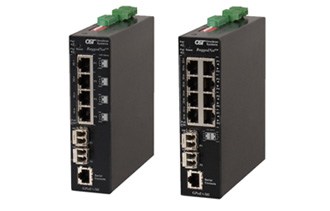PoE Cable Distance
Overcoming the Limitations of Copper UTP Cabling to Wi-Fi Access Points
What is the PoE Cable distance? Power over Ethernet (PoE, PoE+ and HPoE) technology enables powering of IP surveillance cameras through the transfer of DC electrical power along with data over standard Unshielded Twisted Pair (UTP) network cabling. PoE is typically deployed where access to AC power is inconvenient, expensive or infeasible to supply. PoE can power IP cameras located in ceilings, on rooftops, light poles, along fences, pipelines, transit routes and other out-of-the-way locations. The cost of bringing electrical power to each camera is eliminated by powering the equipment through the UTP cable.

The maximum transmission distance of copper UTP cable is 100 meters (328 feet). The challenge is installing Powered Devices (PD) like PoE IP cameras more than 100 meters from the Power Sourcing Equipment (PSE). Using midspan power injectors along the copper cable between network equipment does not extend this distance.
The maximum transmission distance of fiber optic cable is over 100 kilometers (this varies by data rate and optical equipment). Fiber optic cabling overcomes the distance and bandwidth limitations of UTP, but fiber does not carry electric DC current.
Omnitron PoE Fiber Switches and PoE Media Converters extend network distances via fiber to remote cameras AND provide Power over Ethernet.
Products
Omnitron PoE Fiber Switches and Media Converters
OmniConverter® PoE Media Converters
OmniConverter PoE Media Converters enable distance extension over fiber optic cabling and provide PoE (15W), PoE+ (30W) and HPoE (60W) for one or two IP surveillance cameras.
OmniConverter PoE Fiber Switches
OmniConverter PoE Fiber Switches enable fiber network distance extension and provide PoE, PoE+ or HPoE for up to eight IP cameras. They are available with IP-based management via a web interface, Telnet or serial console interface.
RuggedNet® Industrial PoE Fiber Switches
RuggedNet Industrial PoE Fiber Switches enable fiber network distance extension and provide PoE, PoE+, or HPoE for up to eight IP cameras. RuggedNet Industrial PoE Fiber Switches can be deployed in industrial, telecom, utility, IoT, and transportation networks. They are available with IP-based management via a web interface, Telnet or serial console interface.
Enterprise Applications
How PoE Media Converters and PoE Fiber Switches Work
PoE Media Converters and PoE Fiber Switches convert fiber to copper, and function as PoE Power Sourcing Equipment (PSE) to send DC power to one or more Powered Devices (PD) over the UTP cabling. On the left side of the following illustration, an Ethernet switch with RJ-45 ports resides in a server room or security office. The UTP cabling is converted to fiber using a standard media converter. Network switches with fiber ports can also be used.

The fiber is run a long distance to a PoE Media Converter or PoE Fiber Switch located near a convenient AC or DC power source, where it converts the fiber back to UTP cabling. The PoE Media Converter also injects PoE (DC power) over the UTP cable. At the other end of the UTP cable is an IP surveillance camera, located up to 100 meters away from the PoE media converter.
Extend Point-to-Point Fiber to PoE Cameras
PoE Media Converters and PoE Fiber Switches with One Fiber Port
OmniConverter PoE Media Converters, OmniConverter PoE/PoE+ Fiber Switches, and RuggedNet Industrial PoE/PoE+ Fiber Switches with one fiber port can be deployed in point-to-point, or network star topologies. In this application example, PoE, PoE+, and HPoE (60W) IP surveillance cameras are deployed throughout a large facility.
iConverter, miConverter or FlexPoint media converters are installed in a high-density rack-mount chassis to provide reliable and cost-effective fiber distribution from existing copper network equipment.
Fiber cables run to OmniConverter PoE Media Converters and PoE Fiber Switches which are located near convenient AC or DC power sources. The OmniConverter PoE Media Converters provide PoE, PoE+ or HPoE over UTP cables to one or two cameras at each location. OmniConverter PoE Fiber Switches provide PoE or PoE+ to up to eight cameras.

Fiber cables run to OmniConverter PoE Media Converters and PoE Fiber Switches which are located near convenient AC or DC power sources. The OmniConverter PoE Media Converters provide PoE, PoE+ or HPoE over UTP cables to one or two cameras at each location. OmniConverter PoE Fiber Switches provide PoE or PoE+ to up to eight cameras.
Daisy-Chain Fiber and Redundant Fiber to PoE Cameras
PoE Media Converters and PoE Fiber Switches with Two Fiber Ports
PoE Media Converters and PoE Fiber Switches with two fiber ports can be deployed in daisy-chain configurations with fiber links running hop-to-hop along parking lots, border fences, pipelines, highways or rail lines.

PoE Media Converters and PoE Fiber Switches with two fiber ports can also be deployed with redundant fiber links for mission-critical applications that require failover protection. The OmniConverter PoE Fiber Switch in this application diagram is powered by a UPS for battery back-up power. Even if a fiber link is cut and power is shut off, the camera will continue to send image data over the failover fiber link.
Industrial Application
Industrial Manufacturing Application with PoE Fiber Switches
In this industrial manufacturing application example, RuggedNet Industrial PoE Fiber Switches are installed on a DIN-rail along an assembly line. Gigabit fiber is distributed from a fiber switch at a network hub location to RuggedNet PoE Switches with dual
fiber ports that enable a fiber daisy chain with multiple locations. Each RuggedNet PoE Switch provides fiber data connectivity
and 30W PoE+ power per port for four high-speed IP inspection cameras at each location.

Axis Partnership

Omnitron Systems and Axis Communications
Omnitron Systems is an approved Technology Partner with Axis Communications.
OmniConverter PoE media converters and PoE fiber switches are field-tested and fully interoperable with Axis Communications PoE, PoE+ and HPoE (60W) network cameras.











